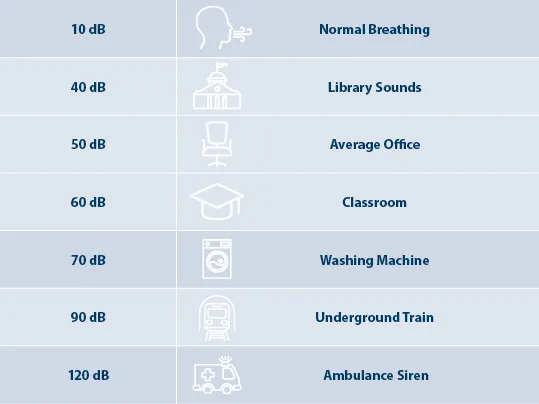Part II: Acoustics for comfort
March 2021
%20(1).webp)
In this 3-part series from Forbo Flooring Systems, we will be exploring the influence and effect of sound in buildings, and how acoustics can be controlled and manipulated for optimal outcomes in specific environments.
The second in our series, this blog focuses on the acoustics challenges present in the healthcare and residential sectors, as well as discussing the optimal acoustic conditions for the leisure & hospitality industry.

Sound has an impact on our quality of life, whatever environment we find ourselves in: whether it’s a place for working, learning, playing, relaxing or healing.
In our previous blog, we established two overarching goals for acoustics management in buildings: reducing unwanted noise and making wanted sounds clearer.
However, there is no one-size-fits-all solution to noise. Specific settings have specific requirements, and therefore deserve specific acoustic treatment. What’s more, it is important to remember that various zones within a single building may also require a different acoustic approach. Considering what each part of a building is used for – receiving people, connecting people, concentrating, recharging – will help illustrate the ideal acoustic environment for a space.
Perhaps more than any other setting, healthcare buildings should aim to create environments that promote wellbeing and health. Acoustics are, of course, just one part of this puzzle. But an important one. A study by AECOM identified sleep and privacy as primary patient needs that are easily impacted by noise.
In-patients need to be getting sound and adequate sleep to support recovery. The sheer numbers of patients, nursing and clinical staff, not to mention tonnes of equipment & machinery present at hospitals, together make for a great many sources of sound. Looking then at the size and layout of most hospital buildings – think open wards and long corridors – along with the endless traffic, comings and goings and dynamic nature of these environments, it is no wonder that sounds from these sources easily saturate what would ideally be a calm and tranquil space.
%20(1).webp)

When it comes to privacy, the acoustic characteristics of a hospital or other healthcare facility should be such that patient confidentiality and dignity are protected. Wards, consulting rooms and suites should optimise speech intelligibility (conversation) whilst reducing sound transmission to and from other areas.
Speech intelligibility is particularly important in care homes. Many elderly people suffer from hearing loss and need all the acoustic help they can get from their environment. Unable to communicate effectively, hard-of-hearing residents can soon find themselves excluded from social interactions and be left feeling lonely and isolated.
Another common ailment among the care home population is dementia. Dementia affects individuals differently, yet it is not uncommon for dementia sufferers’ sensory perception to become altered. These individuals can become highly sensitive to external input – such as light and sound – and are therefore easily overwhelmed and / or distressed. Communal spaces in care facilities should be designed to facilitate conversation, whilst dampening background noise from the kitchen, for example.
Noise is a real and widespread concern among residents all across the real estate value spectrum. Noise interference from outside or from other occupants in the building can significantly impact quality of life; not least when sleep is disrupted. In multi-occupancy buildings, flats and apartment complexes, ‘noisy neighbours’ are a source of significant stress. Indeed, the vast majority of those worst affected by noise lives in apartments. Occupants of these buildings are often surrounded by neighbours on all four sides: left, right, above and below.
More than existing in close proximity, these dwellings literally touch one another: they are part of one and the same structure. These factors create the perfect storm for unwanted noise, which travels through the air and through the structural elements themselves. Lifts, ventilation and heating systems and even plumbing installations add a further and constant layer of background noise to the daily lives of occupants. Design choices should account for each of these potential nuisances – from next door’s TV to the dog barking outside and upstairs reshuffling the furniture.
.webp)

Much like healthcare and residential environments, comfort is paramount at leisure and hospitality venues. These buildings are designed for relaxation and enjoyment. The interior spaces should therefore create a mood that optimises and enhances the visitor experience, not ones that takes away from or spoils it.
We all know how the acoustics in a restaurant, for instance, can make or break an evening. No-one wants to be leaning over their plate of food, shouting to be heard over the other diners, staff and music. However, a certain level of background or ambient noise is desirable here, as it adds to the atmosphere at a bar or restaurant. In terms of the numbers, 25-35 dB is considered faint noise; around 60 dB ambient, and anything 80 dB and above is loud, intense noise (think disco!).
Hotel rooms are another classic example of how acoustics can result in repeat custom or scathing reviews on social media. Consider therefore that the appropriate acoustic treatment in the likes of bars, restaurants and hotels can have a significant influence on overall customer or guest satisfaction.
Acoustic flooring can go a long way to minimising the effects of unwanted noise and creating comfortable indoor environments that are fit for purpose.
When selecting an acoustic floor, it is important to consider the practicalities and remember that acoustics are just one part of the equation. Consider who or what will be using the floor? And in what circumstances?
In healthcare settings, as well as standard footfall, a lot of traffic will come in the form of trolleys and wheelchairs. What’s more, a healthcare environment has high standards of hygiene and cleanliness. The ideal acoustic flooring would therefore combine hygiene with easy rolling. Compact acoustic products, such as Sarlon 15 dB, offer a great solution in such settings.
%20(1).webp)
.webp)
In residential settings, aesthetic and comfort are equally as important as functionality. The same vinyl acoustic flooring can be used effectively throughout an apartment, without compromising on look and feel. Our luxury vinyl tile (LVT) solution Allura Decibel, for example, has been developed to offer 19 dB sound reduction, without compromising on aesthetics or ease of installation.
In recent years, the industrial style has been a recurrent trend in contemporary bar and restaurant design, and with it, lots of high ceilings and hard surfaces. This combination can make sound reverberation an issue. Flooring is an ideal means of absorbing reverberation whilst avoiding the need for breaking with a clean aesthetic with fussy wall panelling, for example.
Contact noise often also plays a role in restaurants and pubs. The less you hear of chairs being moved around, the easier a conversation becomes. A hybrid product is a good flooring solution in these areas, being easy to clean thanks to the vinyl back, and absorbing noise through the textile top layer. Flotex is an example of such a hybrid floor: a high-tech flooring which looks like carpet and feels warm and comfortable.
Of course, we can help you find the right acoustic solution for your specific needs. For tailored acoustic information and advice on your project, our acoustics engineers are here to help, so feel free to get in contact with us.
If you missed our introductory Ear to the ground blog explaining some basic acoustic principles, you can read that here. Be sure to keep an eye out for part 3 of this mini-series on sound, where we’ll be discussing the acoustic issues specific to education and commercial spaces.